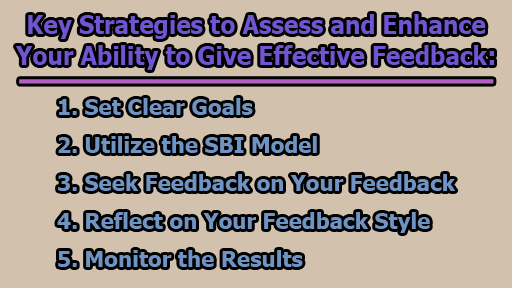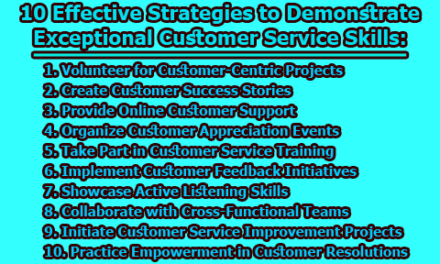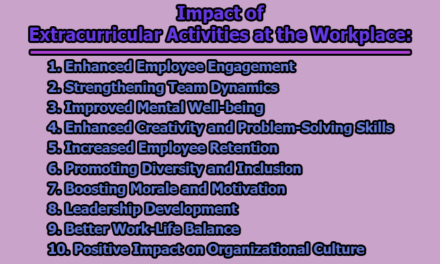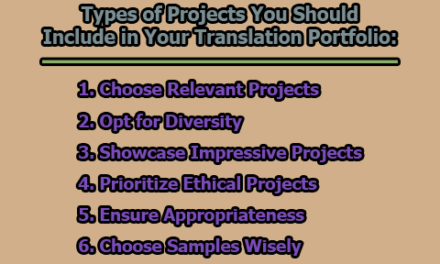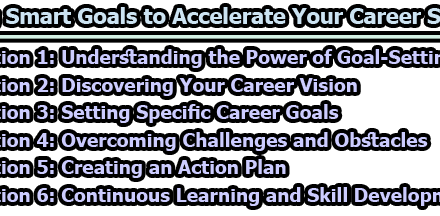Key Strategies to Assess and Enhance Your Ability to Give Effective Feedback:
Providing effective feedback is an essential skill in both personal and professional realms. The ability to communicate constructive criticism, praise, or suggestions in a manner that fosters growth and development is crucial. Evaluating your proficiency in delivering feedback is an ongoing process that requires self-reflection and a commitment to improvement. In this article, we will explore five key strategies to assess and enhance your ability to give effective feedback.
1. Set Clear Goals: The foundation of effective feedback lies in setting clear goals before engaging in the process. Clarity in your objectives ensures that your feedback is purposeful, constructive, and aligns with both your intentions and the recipient’s needs. Begin by identifying the specific purpose of your feedback – whether it is to commend someone’s performance, suggest a change in behavior, or address a specific issue. Understanding the core objective allows you to tailor your feedback accordingly.
Consider the goals, expectations, and needs of the individual receiving the feedback. What are their professional aspirations or personal objectives? Aligning your feedback with their trajectory fosters a more meaningful and impactful exchange. Moreover, it demonstrates that your feedback is not arbitrary but is tailored to support their growth and development.
In addition to individual considerations, carefully choose the methods and channels through which you deliver your feedback. The mode of communication can significantly impact how your feedback is received. Some individuals may prefer face-to-face discussions, while others may find written feedback more digestible. By selecting the most appropriate means of communication, you ensure that your message is conveyed effectively.
Setting clear goals in advance allows you to structure your feedback, making it more coherent and relevant. It provides a roadmap for the discussion, preventing ambiguity and ensuring that the feedback session remains focused and beneficial for both parties involved.
2. Utilize the SBI Model: The Situation-Behavior-Impact (SBI) model serves as a valuable framework for delivering effective feedback. This model encourages a systematic approach, breaking down the feedback into three key components: Situation, Behavior, and Impact.
Begin by describing the specific Situation or context in which the observed behavior occurred. Providing a clear context helps the recipient understand the circumstances surrounding the feedback. For example, “During the team meeting last week…”
Next, focus on the observed Behavior. Pinpoint specific actions or behaviors without resorting to vague or general statements. Instead of saying, “You were disruptive during the meeting,” you could use the SBI model to say, “In the last meeting, you interrupted several times and spoke over others.”
The third component is Impact, which addresses the consequences or results of the observed behavior. Outline how the behavior affected the team, project, or overall collaboration. Using the SBI model helps you move away from subjective opinions and towards objective observations, making your feedback more concrete and actionable.
By incorporating the SBI model into your feedback process, you enhance clarity, precision, and effectiveness. It ensures that your feedback is focused on observable facts and outcomes, reducing the likelihood of misinterpretation and fostering a more constructive exchange.
3. Seek Feedback on Your Feedback: An invaluable method for evaluating your ability to provide effective feedback is to actively seek feedback on your feedback. This involves inviting the individual who received your feedback to share their thoughts and feelings about the experience. By engaging in a two-way communication, you gain insights into how your feedback was received, interpreted, and its potential impact.
Encourage the recipient to express their perspectives on the feedback process. Ask open-ended questions such as, “How did you interpret the feedback?” or “In what ways do you think this feedback can be beneficial for your development?” By doing so, you not only gain a deeper understanding of their perception but also demonstrate a genuine interest in their viewpoint.
Alternatively, involve a third party in the feedback evaluation process. A colleague, mentor, or coach can provide an external perspective, offering constructive criticism and insights into your feedback delivery style. This external feedback can be particularly valuable as it brings an objective viewpoint, helping you identify blind spots and areas for improvement that might not be apparent to you.
By actively seeking feedback on your feedback, you create a culture of continuous improvement and open communication. This process allows you to refine your feedback skills, learn from your mistakes, and build trust and rapport with those you provide feedback to.
4. Reflect on Your Feedback Style: Another critical aspect of evaluating your ability to provide effective feedback is engaging in self-reflection regarding your own feedback style and preferences. Consider how you prefer to receive feedback, as this insight can provide valuable clues on how others may respond to your feedback.
Reflect on your reactions to both positive and negative feedback. Are you open to constructive criticism, or do you tend to be defensive? Understanding your own emotional responses enables you to empathize with the emotions of those you are providing feedback to.
Additionally, analyze how you adapt your feedback style to different situations and individuals. Effective feedback is not one-size-fits-all; it requires flexibility and tailoring based on the unique characteristics of the person and the context. Assess how you balance praise and criticism – finding the right equilibrium contributes to a more well-rounded and constructive feedback approach.
Reflecting on your feedback style allows you to identify your strengths and weaknesses. Recognizing areas for improvement enables you to develop a more flexible, empathetic, and adaptable approach to feedback, enhancing your overall effectiveness as a communicator.
5. Monitor the Results: The final step in evaluating your ability to provide effective feedback involves monitoring the results of your feedback over time. This step is crucial as it allows you to gauge the actual impact and effectiveness of your feedback, ensuring that it contributes positively to the growth and development of the individuals involved.
Assess whether your feedback has led to the desired outcomes or changes. Have the individuals implemented the suggested improvements or changes in behavior? Monitoring tangible results helps you understand the practical implications of your feedback and allows you to make data-driven adjustments to your approach.
Consider whether your feedback has contributed to the individual’s professional or personal growth. Has there been a noticeable improvement in their skills, performance, or collaboration? Effective feedback should inspire positive development, and tracking these advancements provides a measure of the feedback’s success.
Evaluate the impact of your feedback on the relationship between you and the individual. Effective feedback should strengthen relationships by fostering trust and mutual understanding. If your feedback has inadvertently created tension or strained the relationship, it’s essential to identify the root cause and adapt your approach accordingly.
Be vigilant about unintended consequences or issues that may arise from your feedback. Sometimes, well-intentioned feedback may have unforeseen repercussions. By monitoring results, you can identify and address any unintended consequences promptly, mitigating potential issues before they escalate.
Regularly reviewing the results of your feedback loops back into the continuous improvement cycle. It allows you to refine your feedback strategies, adapt to evolving situations, and cultivate a feedback culture that contributes positively to personal and professional development.
In conclusion, by consistently setting clear goals, utilizing effective frameworks like the SBI model, seeking feedback on your feedback, reflecting on your feedback style, and monitoring the results, you can comprehensively evaluate and enhance your ability to provide impactful and constructive feedback. This commitment to improvement not only refines your communication skills but also contributes to a positive and growth-oriented environment within your personal and professional spheres.

Assistant Teacher at Zinzira Pir Mohammad Pilot School and College

